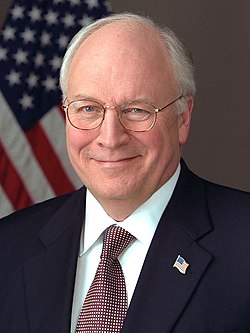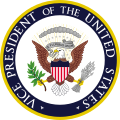 Official portrait, 2003 | |
| Vice presidency of Dick Cheney January 20, 2001 – January 20, 2009 | |
President | |
|---|---|
| Cabinet | See list |
| Party | Republican |
| Election | |
| Seat | Number One Observatory Circle |
|
| |
Dick Cheney served as the 46th vice president of the United States during the presidency of George W. Bush from January 20, 2001, to January 20, 2009. Cheney, a member of the Republican Party, who previously served as the 17th U.S. secretary of defense from 1989 to 1993, was selected as Bush's running mate and took office following their electoral college victory in the 2000 presidential election over Democratic nominees Al Gore and Joe Lieberman. Four years later, in the 2004 presidential election, they defeated Democratic nominees, John Kerry and John Edwards, to win re-election. Cheney is regarded as the most powerful vice president in US history.[1][2]
During Cheney's years in office, the Republican Party also held their majorities in the House of Representatives under Speaker Dennis Hastert and the Senate under Senate Majority Leader Bill Frist during the 108th and 109th U.S. Congress. During Cheney's tenure as vice president, he played a leading behind-the-scenes role in the Bush administration's response to the September 11 attacks and coordination of the War on Terror. His peak approval rating in the wake of the September 11 attacks was 68 percent. Cheney was an early proponent of the Iraq War, with unsubstianted allegations that the Saddam Hussein regime possessed weapons of mass destruction and had an operational relationship with Al-Qaeda. He also pressured the intelligence community to provide intelligence consistent with the administration's rationales for invading Iraq. Cheney was often criticized for the Bush administration's policies regarding the campaign against terrorism, his support of wiretapping by the National Security Agency (NSA), and his endorsement of the U.S.'s "enhanced interrogation" torture program. In 2007, Cheney survived an assassination attempt in Afghanistan.
Near the end of his tenure, Cheney did not run for president as the Republican nominee in the 2008 presidential election and endorsed John McCain, who became the nominee and selected Alaska governor Sarah Palin as his running mate. They lost the 2008 election to the Democratic ticket of junior Illinois senator Barack Obama and his running mate, senior Delaware senator Joe Biden. As vice president in his capacity as the president of the Senate, Cheney oversaw the certification of Obama and Biden as the winners of the election on January 8, 2009. Bush and Cheney were succeeded in office by Obama and Biden on January 20, 2009. Cheney ended his vice presidential tenure as a deeply unpopular figure in American politics, with an approval rating of 13 percent.
- ^ Totenberg, Nina (January 15, 2009). "Cheney: A VP With Unprecedented Power". NPR. Retrieved July 7, 2025.
- ^ "Cheney – Most Powerful US Vice President Ever?". Voice of America. October 27, 2009. Retrieved July 7, 2025.

